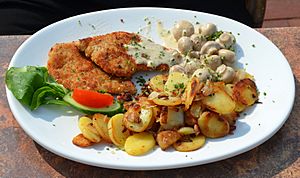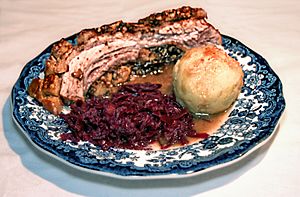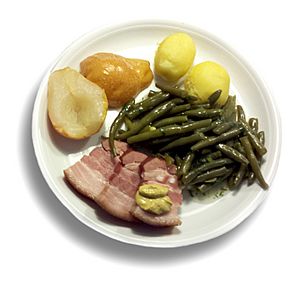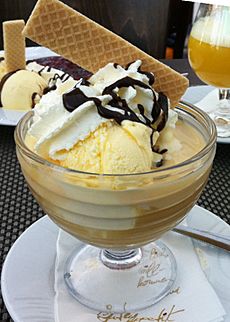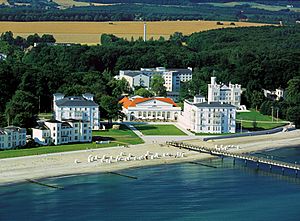Mecklenburg cuisine facts for kids
Mecklenburg cuisine is the traditional food from the Mecklenburg region in northeast Germany. It's known for being simple, filling, and delicious! Many dishes today still have their original flavors, but chefs also find new ways to prepare them. Some old recipes are even being brought back to life.
The food in Mecklenburg shows how people used to live. The region was mostly about farming, so many dishes use simple ingredients. Being close to the Baltic Sea and having many lakes means lots of fresh fish. The big forests also provide plenty of game (wild animals like deer).
Potatoes, called Tüften by locals, are super important here! There's even a potato museum, the Vorpommersches Kartoffelmuseum, nearby. People in Mecklenburg cook potatoes in many different ways. Other common foods include Grünkohl (a type of cabbage) and dishes with a mix of sweet and sour tastes, often using dried fruit. Even though Mecklenburg and Western Pomerania have separate histories, their food is very similar because their landscapes and lifestyles were alike.
In the 1700s, a writer named Carl Julius Weber noted what Mecklenburgers ate. He said,
"The people live mainly off potatoes, dried fruit, white cabbage, turnips and broad beans."
Contents
Delicious Specialties
Mecklenburg offers many unique and tasty dishes. Here are some of the most famous ones:
Fish Dishes
Since Mecklenburg is near the Baltic Sea and has many lakes, fish is a big part of its food.
- Gebratener Räucheraal or Gebackener Spickaal: This is baked or fried smoked eel.
- Gebratene Maischolle or Braden Maischull: This is fried plaice, a type of flat fish.
Pork and Beef Dishes
Meat dishes, especially pork, are also very popular and hearty.
- Kloppschinken: A special kind of ham.
- Topfleberwurst: A type of liver sausage.
- Mecklenburg roast ribs (Mecklenburger Rippenbraten): A famous roast pork rib dish.
Soups, Vegetable, and Potato Dishes
These dishes often use local vegetables and, of course, potatoes!
- Tüffel un Plum: A potato soup with plums and bacon, showing the sweet and sour mix.
- Fliederbeersuppe: A soup made from elderberries.
- Schwemmklöße: Light, fluffy dumplings.
- Buttermilchkartoffeln: Potatoes cooked with buttermilk.
- Birnen, Bohnen und Speck: A dish with pears, green beans, and bacon.
Sweet Treats
For dessert, Mecklenburg has many delicious puddings and cakes.
- Sanddorntorte: A cake made with sea buckthorn berries, which are common in the region.
- Black bread pudding (Schwarzbrotpudding): A unique pudding made from dark bread.
- Rote Grütze: A red berry pudding, often served with cream or vanilla sauce.
- Mandelkringel: A sweet, pretzel-shaped pastry with almonds.
- Sour cream pudding (Schmandpudding): A creamy, tangy pudding.
- Arme Ritter: Similar to French toast, often served with fruit.
- Mecklenburg Götterspeise (Mecklenburgische Götterspeise): A colorful jelly dessert.
- Swedish ice cream sundae (Schwedeneisbecher): A popular ice cream dish.
Christmas Dishes
During the Christmas season, special treats are made.
- Honigkuchen auf dem Blech: A type of honey cake baked on a tray.
- White Pfeffernüsse (Weiße Pfeffernüsse): Small, spiced cookies.
Drinks
Mecklenburg also has some interesting drinks.
- Grog: A warm drink, often with rum, popular in cold weather.
- Mecklenburg country wine (Landwein) from the Stargarder Land: Local wine.
- Sanddorn: Sea buckthorn is used to make wine, spirit, and fruit juice.
Local Beers
Mecklenburg has several breweries that make different kinds of beer.
- Darguner Pilsener, Dunkelbier, Stierbier, Mecklenburger Pilsener, Schloss Hefeweizen, and more, from the Darguner Brauerei.
- Rostocker Pilsener, Bockbier, Dunkelbier, and others, from the Hanseatische Brauerei Rostock.
- Lübzer Pils, Bock, Export, Schwarzbier, Urkraft, Nordbräu Pilsner, and Duckstein from the Mecklenburgische Brauerei Lübz.
Top Restaurants
Mecklenburg is also home to some very fancy restaurants that have won awards for their amazing food. These places are known for their high-quality dishes and talented chefs.
Some of the restaurants that have received special stars from the famous Michelin Guide include the Ostseelounge im Strandhotel Fischland in Dierhagen, the Gourmet-Restaurant Friedrich Franz in Heiligendamm, and Der Butt in Rostock.
The Gault-Millau culinary guide, another important guide for food lovers, also lists top restaurants. The Gourmet-Restaurant Friedrich Franz in Heiligendamm is often ranked as one of the best. Other highly-rated restaurants include the Alte Schule Fürstenhagen and Ich weiß ein Haus am See in Krakow am See. These guides show that Mecklenburg has many excellent places to enjoy gourmet food.
Literature
- Frieda Ritzerow: Mecklenburgisches Kochbuch. Fifth edition, Hinstorff, Rostock, 1990 (an exact copy of the 1868 edition).


